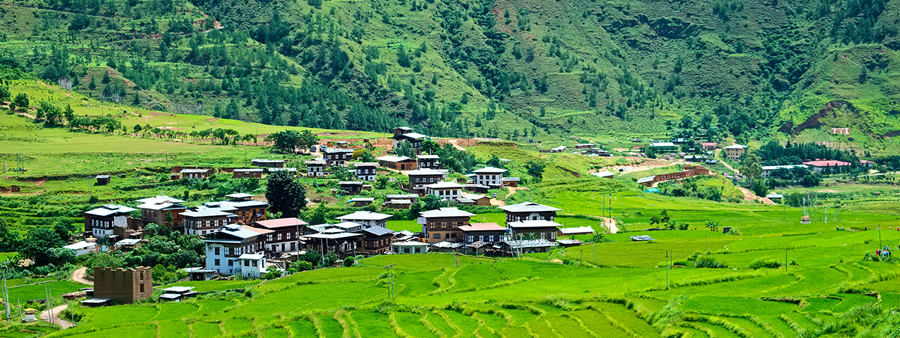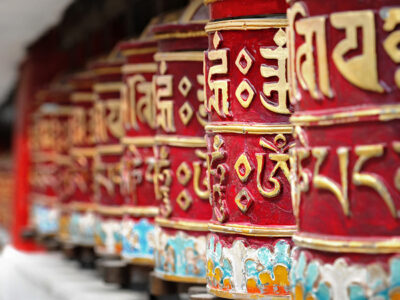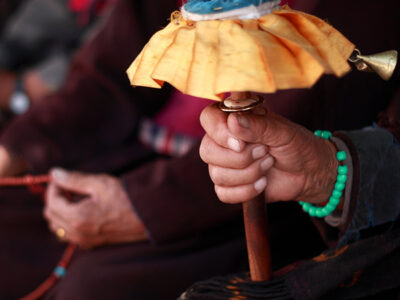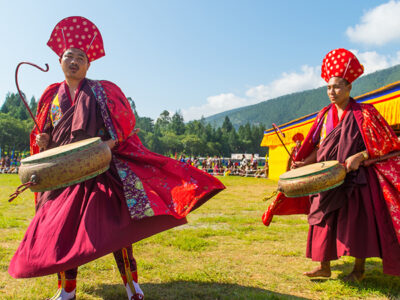An Eco-Trek in the land of the Thunder Dragon – The Nabji Trail

- The beautiful Nabji Trail
- Bhutanese way of life
- Interaction with the local people of the beautiful valley
- Jigme Singye Wangchuck National Park
- Dzong or National Museum, rated among the best natural historic museums in Asia
| Title | An Eco-Trek– The Nabji Trail |
| Details | Delhi – Paro - Thimphu – Wangdue Phodrang – Trongsa – The Nabji Trail - Bumthang – Mongar – Trashigang – Samdrup Jhonkhar – Guwahati – Kolkatta |
| Duration | 19 Nights / 20 Days |
The Nabji Trail is an ideal trek set out in Jigme Singye Wangchuck National Park. Besides the natural beauty of the area, the area also contains cultural history, wildlife, and superb birding opportunities. The last two days of the trek will go through the homeland of the Monpa people. The trail has been developed in such a way that community will have the sole responsibility to manage and provide services.
In the morning you will be transferred to the airport to board your flight for Paro. The rest of the day is at leisure to familiarize you with downtown Paro.
After an early morning breakfast, drive for about 8 km to Satsam Chorten for a half-day hike to Taktsang Monastery. Returning from the monastery visit the Drugyel Dzong built in 1646 by Shabdrung Ngawang Namgyal to commemorate his victory over the Tibetan invaders. Later in the afternoon visit the National Museum, the museum is housed in Paro Dzong’s ancient watchtower.
After a leisurely breakfast you take a drive to Thimphu. The afternoon is at leisure to stroll around the main roads of this wondrous Himalayan Kingdom..
Day 04 : In Thimpu
Today you have a full day to take in the sights of Thimphu that will give you a fairly good exposure and understanding of the Bhutanese way of life, as well as their customs and traditions.
The day begins with a visit to The Textile Museum. From here one can drive up to the Changangkha Lhakhang, which lies on top of the knoll that stands out above. In the afternoon one can visit The School of Traditional Arts where children learn traditional drawing and painting techniques. Those interested in traditional medicine can also visit the Hospital of Indigenous Medicine.
After breakfast you set off on your drive to Punakha. On arrival at Punakha you visit the Punakha Dzong, the winter seat of the Jhe Khenpo (Chief Abbot). The dzong is situated between the Pho-Chhu (male) and Mo-Chhu (female). After leaving Punakha an approx 30 mins drive brings you to Wangdu Phodrang (1,350 m / 4,430 ft. This kind of village with its house all attached to one another is rare in Bhutan.
Departing from your hotel, you stop en-route to visit the Wangdue Dzong built in the 17th century. The Dzong is perched on a spur at the confluence of Punakha-chhu and Tang-chhu River. After your visit you continue your drive to Trongsa. Along the way, also visit the Chendebji Chorten built in the 18th century. You see Trongsa Dzong at the end of the valley 20 km before reaching it.
The Jangbi village guide steers you down to the Mangdi River where you cross a suspension bridge. The first day brings you in contact with the Monpas who are believed to be the first inhabitants of Bhutan.
The morning allows you to further interact with the Monpas. Before you proceed, you could pay a visit to the orchid garden till your thirst for botanical photography gets satiated. The hike to Kudra provides a nuance of jovial atmosphere because this part of the trail meanders along stone imprints of Guru Rinpoche’s footprints, dagger and phallus, festooned by stories that espouse Guru’s praxis
You wake up with the distant call of the Rufous-necked hornbill. This part of the trek is a collage of streams, waterfalls and thick forests that will give you an invigorating feeling of being out in the wild. The Great Himalayan Squirrel, Rhesus Mecaques, and small snakes are often spotted along the trail. Nabji is a beautiful village with endless paddy fields demarcating the valley and surrounding the campsite.
En-route to Korphu, the Nabji temple is located in the middle of the paddy fields. You could also pay a visit to the village temple that houses the sacred relics of Pema Lingpa, the famous ‘Treasure revealer’ of Bhutan. The village campsite provides a spectacular bird’s-eye view of Nabji and surrounding areas.
The hike from Korphu to Nyimshong is pleasant and arguably the best birding spot which can boast a bird list of more than 395 species, with among others the elusive Rufous Necked Hornbill who has its nesting holes adjacent to the trail. The evening brings you to Nyimshong, a village with its reticent architecture and lifestyle.
If you are lucky, the Golden langurs will lead you to the exit. You descend down to the Mangdi River again to see some herons and River-lapwings. An hour’s steep ascend to the road and your driver will drive you back to Trongsa.
After breakfast visit the Trongsa Dzong built in 1648. The landscape around Trongsa is spectacular and for miles on end the Dzong seems to tease you so that you wonder it you will ever reach it. After the visit you continue your drive to Bumthang. You drive to the Choekhor Valley to the village of Chamkar, which has grown up on flat ground at the base of its hill. The place is more normally referred to as Jakar.
After breakfast you visit Jampa Lhakhang. This temple is said to be the first that King Songtsen Gampo of Tibet constructed in Bhutan in the 7th century. Thereafter you proceed along the road from the village that ends at Kurjey Lhakhang. Kurjey’s site is one of the most sacred in Bhutan as Guru Rinpoche meditated here and left the imprint (jey) of his body (ku) on a rock. After visiting these two places you hike to Shukdra Monastery, an ancient monastery wedged on a cliff like Taktsang Monastery in Paro. One way hike to Shukdra will take about 45 minutes. In the evening visit Jakar Dzong. The Dzong is perched on a spur overlooking the valley.
You proceed further eastwards from Bumthang to Mongar. The route will take you via the Sheltang La (pass) (about 3650 m) and the Thrumshing La (pass) (about 3900 m). Thrumshing La pass is the highest motorable pass in the Kingdom. Enroute you will also come over head spinning towering cliffs and waterfalls.
Today you proceed for and excursion drive to Lhuentse district. Lhuentse is one of the most far flung remote districts of Bhutan. In Lhuentse, visit the Lhuentse Dzong and catch a glimpse of women weaving at Khoma if time permits..
Today, after breakfast, you drive from Mongar to Trashigang. After lunch visit the Trashigang Dzong and later visit the Rangjung. Drive from Trashigang town to Rangjung takes about 30 minutes. The evening is at leisure.
To exit out of Bhutan and enter India in the state of Assam, you continue your drive to Samdrup Jhonkhar.
Today you drive to Guwahati where on arrival you drive up to Nilachal Hill to see the holy Kamakhya Temple. In the afternoon visit the poignant Common wealth War Graves cemetery. Finally walk through a local market in the evening.
You will be transferred in time to the airport to board your flight to Kolkata.



